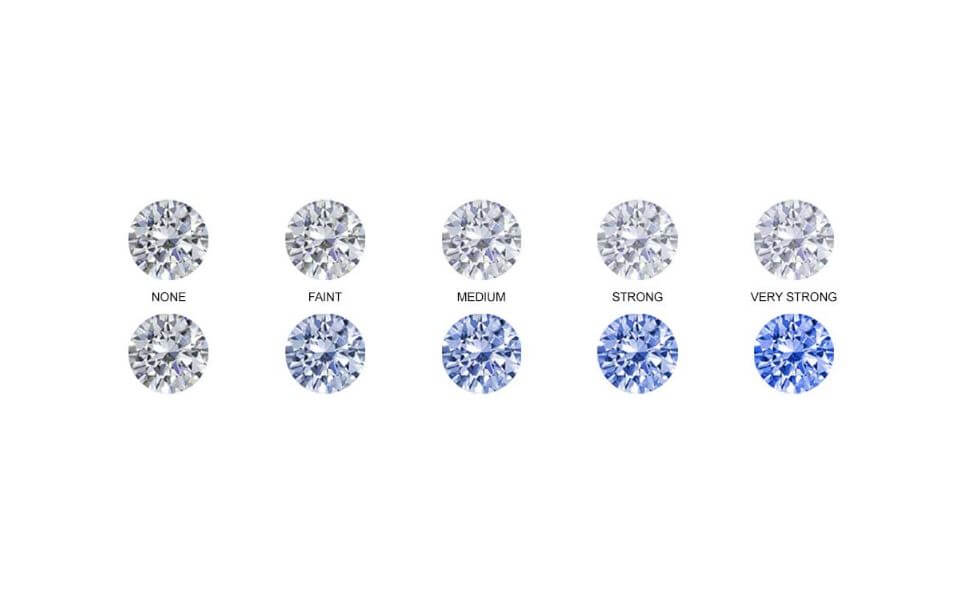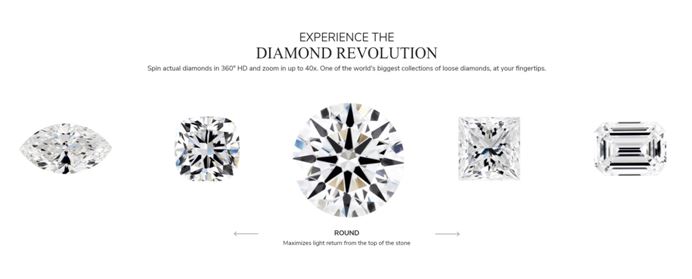The value of every diamond is in its ability to reflect out as much light as possible, including the invisible light, also known as UV light. When diamonds are exposed under UV light, they fluoresce. Usually, the color of the emitted glow is blue but can range from green, yellow, and even red.
About 30% of all diamonds espouse this phenomenon with most jewelry enthusiasts considering it as a defect. However, in some cases, the fluorescence is desired especially when it makes diamonds in the warm color grades between I to M brighter and whiter. That notwithstanding, the fluorescence can lower the quality of the diamond especially when it’s excessive and easily noticed even under normal daylight.
However, efforts should be made to ensure that the fluorescence of a diamond does not suppress its quality depending on its cut grade, color, and carat weight. When looking to purchase your diamond, these three factors should be in your mind should fluorescence be a hindering factor.
Summary
About 30% of all diamonds emit fluorescence. This is considered a defect that drives the prices of such diamonds lower by 15%. However, diamonds in the warm colors grades of I to M usually sell at a higher price if they have strong fluorescence which offsets the warm color and makes the diamond more brilliant.
Several factors affect the diamond’s fluorescence. These include the color grade, the carat weight, as well as the cut grade. It should be noted that fluorescence is a highly subjective factor and each buyer may have their tastes and preferences. If you love your diamond with strong fluorescence, then with all due respect, follow your heart.
The color Grade
The Gemological Institute of America conducts laboratory experiments on diamonds and helps grade diamonds according to their color. While most diamonds can be perceived as brilliant by the naked eye in broad daylight, most of them have internal color usually brought about by the rough stone chemical properties and cut grade.
The color grade of diamonds is labeled from D-M with the D-F color grades considered to be colorless and the I-M color grades considered as warmer or yellowish. To that end, the diamond’s fluorescence becomes a major factor to consider. Ideally, the blue fluorescence in diamonds with color graded D-F has considered a defect and undesirable simply because these color grades are brilliant and clear without it. However, in the I-M color grades, the fluorescence helps offset the warm colors and gives the diamond a more brilliant appearance.
Carat weight
The carat weight of a diamond is how heavy or large a diamond is. One carat is equivalent to 0.2 grams. Diamonds of larger carat weight usually have easily visible colors and hence are affected more by the fluorescence. It goes without saying that the larger the diamond, the greater the effect of the fluorescence.
Smaller diamonds, on the other hand, have easily negligible colors and hence their fluorescence may not be as significant. However, too much fluorescence can easily be detected even on a small diamond. It is therefore important to ensure that whatever size of diamond you buy, it’s tested under UV light to ascertain its fluorescence level.
Cut grade
When poorly cut, diamonds tend to be less brilliant. In such instances, the fluorescence of a diamond may become more prominent and easily noticeable because it’s not reflecting much of its light. Before considering fluorescence, perform a cut grade check and ensure that the diamond meets all the prerequisites of a good quality diamond according to the GIA. Once that’s established, judging the fluorescence will be easier and accurate.
How is fluorescence in diamonds graded?
The fluorescence of diamonds is graded from none, faint, medium, strong, to very strong. The Gemological Institute of America has done extensive lab experiments and came up with those five levels of grading fluorescence. A diamond graded “none” means that there’s no fluorescence from the diamond and effectively, the diamond is invisible under UV light. Strong to very strong fluorescence means that the diamond emits a strong blue glow when placed under UV light.
The GIA also researched to see the effect of fluorescence of diamonds on the buyer’s perception. They placed different types of diamonds under normal lighting conditions and asked prospective buyers, both experts, and amateurs, to determine which diamond looked best.
The GIA determined that the fluorescence of the diamond is unnoticeable when the diamond is upside down. And even when right side up, the buyers were conflicted on which diamond looked the best, leading to the conclusion that the effect of fluorescence is highly subjective from diamond to diamond and from buyer to buyer.
How does it affect a diamond’s quality and price?
As stated, fluorescence is a highly subjective quality of diamonds. Every buyer has their preference and what may be considered beautiful by one buyer based on its fluorescence may be abhorred by another one. To that end, judging a diamond by its fluorescence emission is best determined by your heart’s desires. There’s no one-size-fits-all rule on fluorescence.
However, according to the GIA, the fluorescence may have effects on other aspects of the diamond. For instance, the fluorescence is considered to reduce the brilliance of diamonds with a color grade of D-F while enhancing the appearance of diamonds with color grade I-M. That notwithstanding, the fluorescence of the diamond is mostly negligible when viewed by the naked eye in daylight.
A diamond with very strong fluorescence, however, will appear more cloudy, bluish, or less brilliant than one without it. Even though the fluorescence may make diamonds with color grades I-M appear brighter, the brilliance of the diamond may appear cloudy if the fluorescence is extremely strong. To that end, buyers should embrace fluorescence in diamonds with color grades I-M and avoid diamonds with strong fluorescence in color grades D-F.
Due to this interesting aspect and subjectivity of the diamond fluorescence, prices tend to be higher for diamonds with color grades D-F that have none or faint fluorescence as they’re considered the higher quality and lower prices if they have strong fluorescence. For diamonds with color grades I-M, the fluorescence is a desired trait which raises the prices of this group of diamonds by a premium as more buyers are willing to purchase the diamonds with strong fluorescence, all other factors constant.
Tips to consider when buying a diamond with Fluorescence
As seen above, fluorescence is not necessarily a bad trait of diamonds. Some diamonds appear more beautiful with fluorescence, others, not so much. The degree of fluorescence desired is left on the buyer to decide as well as on the color grade of the diamond. The size of the diamond also affects how fluorescence appears in the diamond.
To help you make a good purchasing decision when buying your diamond, consider these factors when buying a diamond with fluorescence. However, at the end of it all, remember to follow your heart. When it comes to fluorescence in diamonds, you’re the kingmaker.
The color grade
Diamonds are graded according to the color they possess. While it may sound ludicrous that diamonds possess color, you’d be surprised at how easy this factor gets overlooked by most jewelry buyers when purchasing diamonds. Indeed, the diamond’s color is not easily perceived by the naked eye from afar in broad daylight, but when closely examined, it becomes evident.
According to the GIA, the color grade of diamonds ranges from D to M. Each later designating the amount of color found in a diamond in ascending order. Diamonds graded between D-F are considered fairly colorless. Between G and H, they’re considered to have faint colors, and from I to M, they are considered to be warm-colored. Some diamonds have other colors such as green, red, etc. It depends on the rough stone from which the diamond was cut from.
Fluorescence becomes important when it comes to grading the quality of diamond because it has a perceived effect on its brilliance. Perceived, because what one buyer might consider desirable may not be desirable to another buyer.
Fluorescence, at its basic level, is an emission of a blue glow by a diamond when placed in ultraviolet rays, also known as black light. Diamonds that emit excess fluorescence will glow with blue light while those that have none to faint fluorescence will remain invisible under UV light.
To that end, colorless diamonds with none to faint fluorescence are considered to be higher quality than with fluorescence simply because it affects their brilliance. Diamonds with warm colors of I to M with strong to very strong fluorescence are preferred as the yellowish colors help offset the blue emission of fluorescence making the diamond appear whiter and brilliant.
Carat weight
The carat weight of the diamond is an equally important factor when it comes to buying diamonds with fluorescence. The carat, which is the unit of measurement for diamond’s weight and size, is equivalent to 0.2 grams. Therefore, a very small diamond with color grades on the high end of the color spectrum may easily become negligible or unnoticeable simply because of its size. In such an instance, the fluorescence of the diamond becomes less significant. However, to maximize the brilliance of the colorless diamonds, it’s still preferred to buy a diamond with none or faint fluorescence.
As for the warm-colored diamonds in the I to M color grades, strong fluorescence is always preferred to offset the warm color of the diamonds. It should be noted that most buyers don’t prefer the warm-colored diamonds and hence the preference for them to have fluorescence. For this reason, the warm-colored diamonds with very strong fluorescence are priced higher than their counterparts without.
Price
Fluorescence has a significant effect on the price of the diamond and only because of the perceived enhancement it does to the warm colored diamonds. However, on the clear diamonds, the fluorescence has the effect of reducing its price as it’s perceived to lower its brilliance.
Nevertheless, fluorescence should not be the main determinant when purchasing a diamond especially if it’s effect on the price is significant. Checking the cut grade and the carat weight should be your first stop because taking into consideration the price. But as stated, the price of the warm-colored is significantly affected by fluorescence because of its ability to offset the warm colors.
Tastes and preferences
Now, being that as it may, not every buyer will prefer a warm-colored diamond with fluorescence. Some just want the yellowish diamond as it is as they feel it gives them a unique advantage and distinct appearance. Fluorescence is not a measure of the diamond’s quality and should therefore not be used to determine the quality of the diamond. However, because of its perceived advantage on the warm-colored diamonds, it often becomes a desirable effect as well as a defect on the colorless diamonds.
Your tastes and preferences should dictate the type of diamond you want. If you love your diamond all warm and distinct, then with all due respect, get yourself the warm-colored diamonds without fluorescence. If you love them with fluorescence, then get them too.
The jewelry
Now, depending on the type of jewelry you want your diamond to be on, fluorescence can make or break its beauty. For instance, rings tend to conceal color and fluorescence much better than, say, necklaces. In such an instance, fluorescence on a diamond that is going to be set on a ring can be neglected since for it to become visible, one has to view it up close.
On the other hand, if your diamond will be set on a necklace, then the diamond should be clear and with none or faint fluorescence to enhance its brilliance and make it stand out, unlike the warm colors. Still, you can ensure that if you purchase the warm-colored diamond, on whatever setting the diamond will be in, that the fluorescence complements the warm color and makes it appear more brilliant and whiter.

